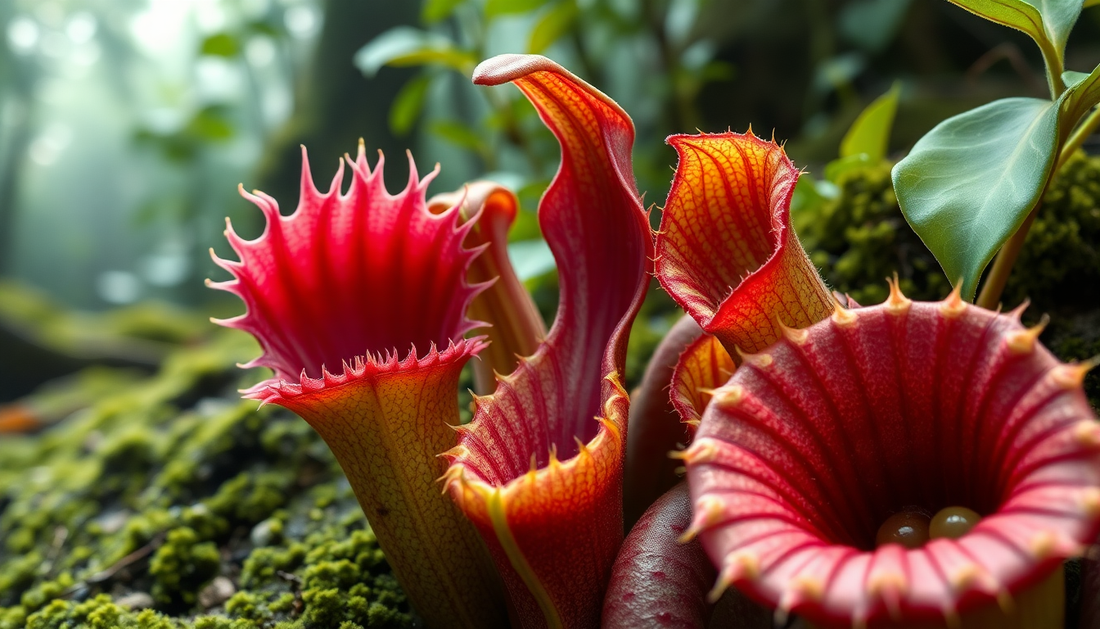
The Secret to Thriving Carnivorous Plants: A Care Guide from The Secret PlantHouse
Share
Welcome to the world of captivating carnivorous plants! At The Secret PlantHouse, we are passionate about these unique and fascinating flora, and we're thrilled to share our expertise with you. Whether you're a seasoned plant enthusiast or just starting your journey into the realm of carnivorous wonders, this comprehensive guide will equip you with the knowledge and techniques to help your plants thrive.
Understanding Carnivorous Plants
Carnivorous plants are a truly remarkable group of species that have evolved to supplement their nutrient intake by trapping and consuming insects and other small prey. From the iconic Venus flytrap to the mesmerizing pitcher plants, these plants come in a wide variety of shapes, sizes, and adaptations. Understanding their natural habitats, biology, and survival mechanisms is the first step in providing them with the care they need to flourish.
Types of Carnivorous Plants
The world of carnivorous plants is diverse and fascinating. Some of the most well-known varieties include:
- Venus Flytraps (Dionaea muscipula)
- Pitcher Plants (Nepenthes and Sarracenia species)
- Sundews (Drosera species)
- Butterworts (Pinguicula species)
- Bladderworts (Utricularia species)
Each of these plants has unique features and adaptations that allow them to thrive in their natural environments, which are often nutrient-poor and challenging.
Natural Habitats and Adaptations
Carnivorous plants are found in various parts of the world, from the bogs and wetlands of North America to the tropical rainforests of Southeast Asia. These plants have evolved to survive in habitats where the soil is lacking in essential nutrients, such as nitrogen and phosphorus. To compensate for this deficiency, they have developed specialized trapping mechanisms to capture and digest insects and other small prey, which provide them with the necessary nutrients for growth and reproduction.
Essential Care Fundamentals
Providing the right care for your carnivorous plants is crucial to their long-term health and success. At The Secret PlantHouse, we've honed our expertise over the years, and we're excited to share our best practices with you.
Light Requirements
Carnivorous plants are generally sun-loving species and require ample exposure to bright, direct sunlight. Venus flytraps, for example, thrive in full sun, while some pitcher plant varieties may tolerate partial shade. Ensuring your plants receive the appropriate amount of light is essential for their growth and trap formation.
Watering Techniques
Proper watering is a critical aspect of caring for carnivorous plants. These plants are adapted to live in moist, nutrient-poor environments, and they require consistently moist soil to survive. Avoid letting the soil dry out completely, as this can be detrimental to your plants. Additionally, be mindful of the water quality, as carnivorous plants are sensitive to chemicals and minerals often found in tap water.
Soil and Nutrient Needs
Carnivorous plants require a specific soil mixture that mimics their natural growing conditions. A well-draining, nutrient-poor potting mix, often supplemented with sphagnum moss or perlite, is the ideal substrate. Avoid using regular potting soil, as it can be too nutrient-rich and lead to problems. Additionally, these plants do not require additional fertilizers, as they obtain their nutrients from the prey they capture.
Temperature and Humidity Considerations
Carnivorous plants thrive in a range of temperature and humidity conditions, depending on the species. Some, like the Venus flytrap, prefer cooler temperatures, while others, such as tropical pitcher plants, require warmer environments. Maintaining the appropriate temperature and humidity levels is crucial for the overall health and growth of your plants.
Specific Care Guides
Now that we've covered the essential care fundamentals, let's dive deeper into the specific needs of some of the most popular carnivorous plant varieties.
Venus Flytraps
Venus flytraps (Dionaea muscipula) are perhaps the most well-known and iconic of all carnivorous plants. These fascinating plants require bright, direct sunlight, consistently moist soil, and a period of dormancy during the winter months. Proper feeding and trap maintenance are also crucial for their long-term success.
Pitcher Plants
Pitcher plants, including both Nepenthes and Sarracenia species, are known for their unique, pitcher-shaped traps that lure and capture prey. These plants require high humidity, ample sunlight, and a carefully balanced watering regimen to thrive. Maintaining the proper soil mix and providing the right amount of nutrients are also essential for their growth.
Sundews
Sundews (Drosera species) are captivating carnivorous plants that use sticky, glandular leaves to trap their prey. These plants prefer bright, indirect light, consistently moist soil, and high humidity levels. Proper feeding and trap maintenance are crucial for their well-being.
Butterworts
Butterworts (Pinguicula species) are another fascinating group of carnivorous plants that use sticky, glandular leaves to capture their prey. These plants require bright, indirect light, consistently moist soil, and a specific soil mix that includes peat moss or sphagnum moss.
Unique Care Challenges
While each carnivorous plant species has its own unique care requirements, there are some common challenges that growers may face. These include dealing with pests, managing dormancy periods, and ensuring the proper balance of light, water, and nutrients. By understanding these challenges and learning effective troubleshooting techniques, you can overcome any obstacles and help your plants thrive.
Common Mistakes and How to Avoid Them
Caring for carnivorous plants can be a rewarding but sometimes challenging endeavor. To help you avoid common pitfalls, we've compiled a list of the most frequent mistakes and how to prevent them.
Overwatering
One of the most common issues with carnivorous plants is overwatering. These plants are adapted to live in moist, nutrient-poor environments, but too much water can lead to root rot and other problems. Ensure that your plants have well-draining soil and that you're not letting the soil become waterlogged.
Incorrect Soil Mixtures
Using the wrong soil mix can be detrimental to your carnivorous plants. Avoid regular potting soil, as it is often too nutrient-rich. Instead, opt for a well-draining, nutrient-poor mix that includes sphagnum moss, perlite, or other suitable amendments.
Improper Feeding
While carnivorous plants do require the nutrients they obtain from their prey, overfeeding can be just as problematic as underfeeding. Be mindful of the appropriate feeding schedule and portion sizes for each species, and avoid introducing prey that is too large for your plants to handle.
Lighting Issues
Insufficient or improper lighting can severely impact the growth and development of your carnivorous plants. Ensure that your plants are receiving the appropriate amount of bright, direct sunlight (or artificial light) for their specific needs.
By being mindful of these common mistakes and taking the necessary steps to address them, you can set your carnivorous plants up for long-term success and enjoyment.
Advanced Care Techniques
As your knowledge and experience with carnivorous plants grow, you may want to explore more advanced care techniques to take your plant-keeping to the next level.
Propagation Methods
Many carnivorous plant species can be propagated through various methods, such as division, leaf cuttings, or seed germination. Mastering these propagation techniques can allow you to expand your collection and share your passion with others.
Seasonal Care Adjustments
Carnivorous plants often require specific care adjustments based on the changing seasons. Understanding the dormancy periods, growth cycles, and environmental needs of your plants will help you provide the optimal care throughout the year.
Troubleshooting Plant Health
Even with the best care, carnivorous plants may occasionally face health challenges. Developing the skills to identify and address issues such as pests, disease, or nutrient deficiencies will help you keep your plants thriving.
Conclusion
At The Secret PlantHouse, we believe that the joy of caring for carnivorous plants is in the journey of discovery and the satisfaction of watching these remarkable plants thrive. By following the care principles and techniques outlined in this guide, you'll be well on your way to cultivating a thriving collection of carnivorous wonders.
Remember, every plant is unique, and the key to success is to observe, experiment, and adapt your care methods to the specific needs of your carnivorous companions. Embrace the challenges, celebrate the victories, and most importantly, have fun on this captivating journey into the world of carnivorous plants.
Happy growing!
